Clara Barton
Contributors
- Jayden Cooper
- McKensie Hone
- Birk Gundersen
- Lexie Lifferth
- Alanna Van Pelt, RN, BSN
- Dani Thornton
Editors/Reviewers
- Sean N. Bennett, RN, MSN - Associate Professor - Utah Valley University
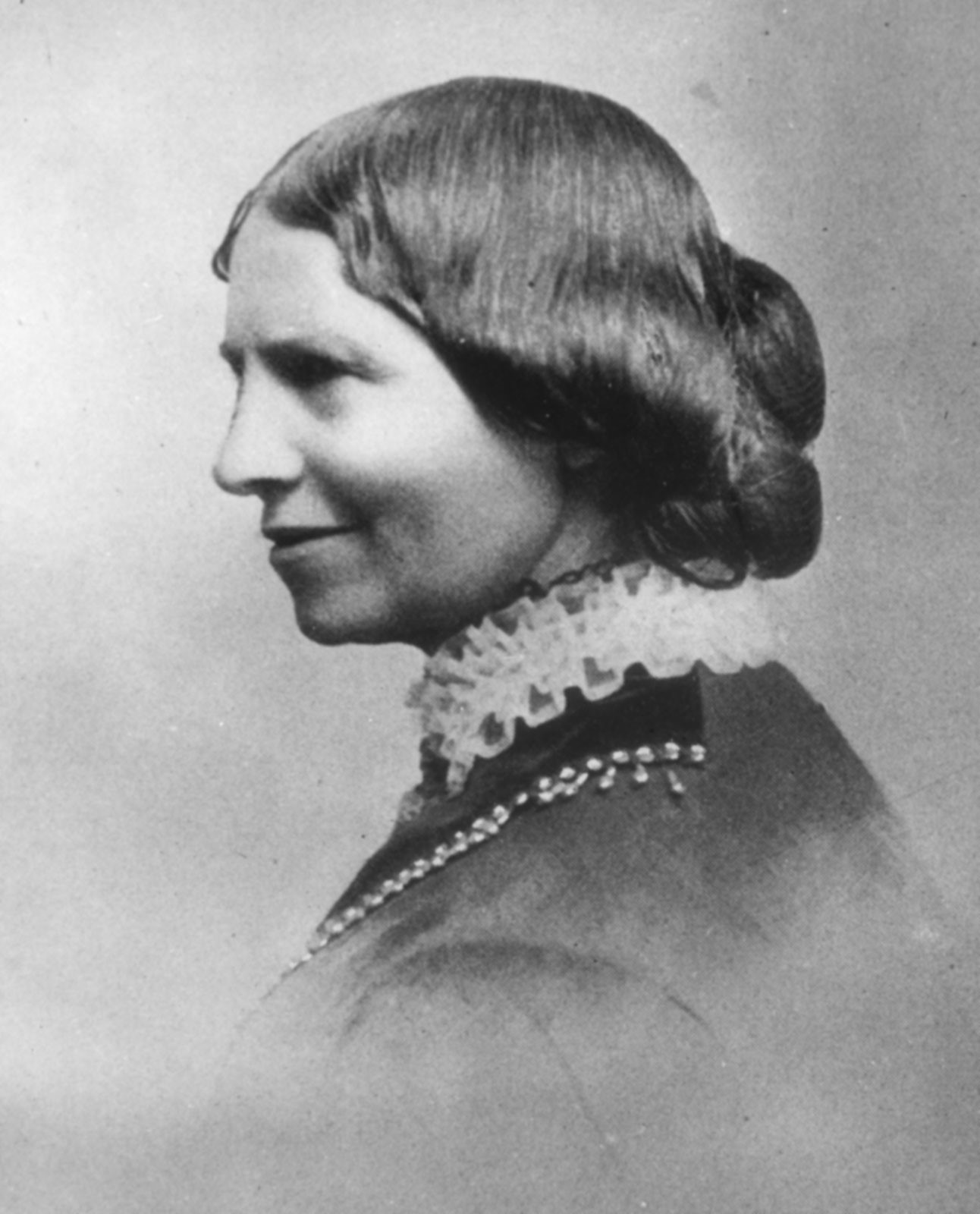
The Early Years
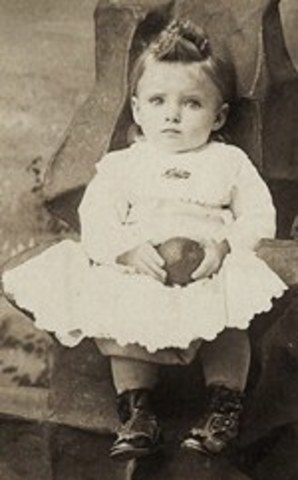
Clarissa Harlow Barton was born in North Oxford, Massachusetts on December 25, 1821 to Stephen and Sara Barton (Britannica, T. E., 2019). She had a great sense of purpose and a genuine and deep concern for her fellow beings throughout her life. Clara's father was a captain of the local militia and was known as "Captain Stephen Barton." He was a veteran of the Indian Wars and often recounted his experiences during that time. He taught all of his children that to give your life for a cause like your country is a great thing, and that being a good American required serving one's country and obeying its laws.
In addition to lessons he shared with her from experiences he had on the battlefield, Stephen Barton also taught Clarissa about geography (Clara Barton Childhood, n.d). Stephen's knowledge and experience regarding the nuances of war, which he imparted to Clarissa from an early age, later helped her when she served as a nurse during the civil war. Stephen doted on Clara and was known as a good, generous man that often helped the less fortunate. He was also a successful farmer, owned and operated a sawmill, and served in the Massachusetts legislature. Stephen's experiences as a veteran influenced Clara's tender feelings for the soldiers, she would later aid.
Clara's mother, Sara Stone Barton, was known for her thriftiness and her temper (Clara Barton Family, n.d). Sara was a very strict mother. She was practical and was known for her common sense. She taught Clara how to sew and cook and do the things that many young women learned to do at that time. Clara was the youngest of five children. Her older siblings were Dorothea, Stephen, David, and Sarah. While her mother taught Clara the skills a young woman should have, her older brothers taught her how to ride a horse bareback, climb trees, and play baseball. Although she was a shy child, these activities taught her a certain toughness that would help her throughout her life.
Clara learned how to tend to and nurse others at a very young age. It is said that her love for nursing developed after her older brother David at the age of 25, fell from a rafter in a barn when Clara was only 11 years old (National Park Service, 2018). David suffered a severe head injury, and no one could stop his constant fevers after the accident. Clara stayed home from school to help nurse David. She administered his medications and tended to him by following his physician's orders to "bleed the patient" by adding and removing leeches (Clara Barton Family, n.d.). Clara was essentially her brother's nurse for the next two years. Owing at least in part to Clara's care, David would later become an Assistant Quartermaster in the Union Army during the Civil War and was known as "Captain David Barton".
Clara learned an important skill or life lesson from each of her siblings. Her oldest brother, Stephen Barton, taught Clara mathematics. It is said that Clara's fondest memory of Stephen was when he defended her right to work at the Satinet Mill after the two years she spent taking care of her brother, David (Clara Barton Family, n.d). Clara's sisters taught her how to read. Clara was especially close to her older sister Sara or "Sally" as she was also called. She later lived near Clara in Washington DC and helped her collect food, clothing and medical supplies for the Union troops.
Clara started school at the age of four. She was very studious, but her shyness affected her. When Clara was eight years old, she had not made a single friend and her parents sent her to a boarding school to help with her shyness. However, it seemed to make the issue worse and her parents ended up withdrawing her from the boarding school soon after (Clara Barton Childhood, n.d.).
Clara began supplementing her education with work experience at a young age. She gained her first experience by working for her oldest brother as his clerk and bookkeeper (American Battlefield Trust, 2018). Though Clara was introduced to nursing as a child while tending to her brother, she did not return to nursing for another 30 years. Clara never actually attended a nursing school or had formal training in nursing. However, she learned and developed her nursing skills through experience.
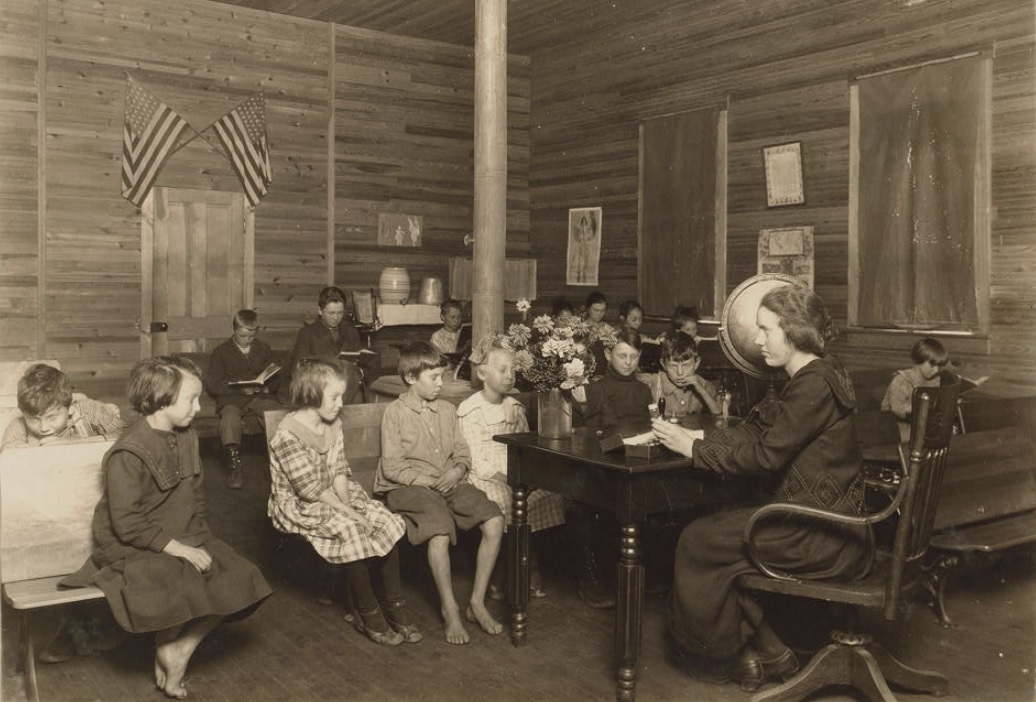
Clara began teaching at the age of 15 during a time when most teachers were men. At the time, corporal punishment was the standard method of discipline for students. However, instead of using the common and accepted painful punishments of the time, Clara used kindness and persuasion and treated each of her students as fairly as possible. She attended the noon recess with her students in an effort to maintain supervision of them and discourage them from playing too rough with one another (Clara Barton Childhood, n.d).
In 1845 At age 24, Clara recognized that the children of the workers at her brother's mill lacked opportunities for education, so she founded a school for them to attend at the mill (Michals, 2015). Clara began traveling from town to town, teaching at different schools. Towards the end of 1850, she decided to return to college in order to gain more education. Clara only attended college for a year before moving in with some friends in New Jersey and opening a free public school in Bordentown. The school was founded in 1852 and started with only six students. Initially Clara was unpaid, but Clara gradually expanded the school to 600 enrolled students, and eventually began earning a salary. Clara's success in her endeavors to impart education showed her strength and talent in organizing, managing, and administering.
Clara was ultimately pushed out of her position as headmaster by the school board who voted to replace her with a male counterpart who had been making double her salary. Undeterred by this misogynistic injustice, she moved to Washington, DC shortly after and was hired by the US Patent Office as a recording clerk. True to her character as a pioneer, Clara became the first woman to be hired for a position like this. Unlike the salary she was paid as headmaster of the school she founded, at the US Patent Office, Clara was paid $1,400 annually, which was the same as her male colleagues (Michals, 2015). Clara believed and was determined that if she was doing a job that a man could do, she would not work less than the man's pay (Editors, 2009).
Unfortunately, her second year working there she was reduced to copyist with a lower salary by Secretary of the Interior- Robert McClelland - who was opposed to women working in the government. In 1857, her position was dropped entirely, by the Buchanan Administration, putting Clara out of a job. After losing her job, Clara returned home to Massachusetts where she lived for the next three years (Van Hartesveldt, 2018).
After President Abraham Lincoln was elected and inaugurated into office, he invited women back into government offices (Stevenson, 2017). Clara returned to the Patent Office and continued her job as a copyist in 1860. She continued working there until the Civil War broke out in 1861 (Michals, 2015).
Education and Volunteerism
When the American Civil War broke out, wounded soldiers from the sixth Massachusetts Infantry were transported to Washington D.C to recover. Clara wanted to help her country and the wounded men, so she went to the railroad station and nursed 40 wounded soldiers (Clara Barton Wikipedia, 2019). As wounded Union soldiers continued pouring into the Washington D.C. area, Clara had compassion on them and wanted to help them. Despite not having any formal nursing training, Clara used the experience she had gained tending for her brother David to help care for the wounded and dying troops.
Clara recognized some of the injured men that she cared for in the 21st Regiment Massachusetts Volunteer Infantry as men from her hometown of Oxford and had even taught some of them in school. She saw that these men had nothing and gathered supplies for them as they lay wounded in Washington, D.C.
The tragedies of the American Civil War inspired Clara to begin her work as a great humanitarian. This work would impact the rest of her life (Van Hartesveldt, 2018). As men were entering Washington D.C., they had only what was carried on their backs, Clara immediately worked to aid these men by working to supply them with food, bandages, and other items. The supplies Clara provided were acquired through her personal sacrifice and by soliciting donations from her friends and acquaintances.
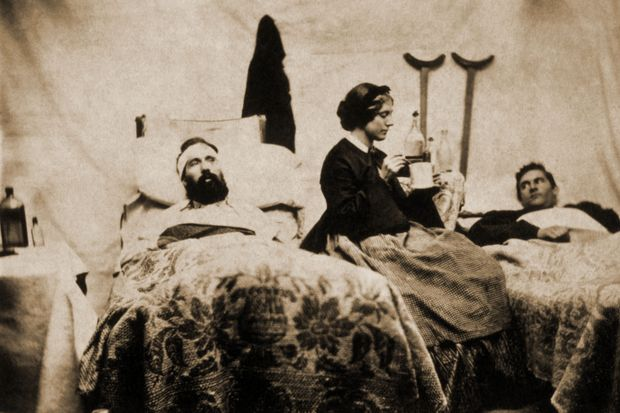
The wounded soldiers were housed in the Capitol Building. With help from other women in the community, family, friends and even strangers, Clara was able to provide items the soldiers needed in order to recover. Clara was inspired after she helped the men of her hometown. She soon left her job as a copyist at the Patent Office in order to give her full devotion to any and all soldiers in need of care (Stevenson 2017).
Clara Barton and the Red Cross
After the ending of the civil war in the United States, Clara went to Europe looking for respite from the difficulties caused by the war. During her time in Europe, Clara was introduced to the International Red Cross. The Red Cross was an idea that was pioneered by Henry Dunant where countries would sign a treaty promising care for the sick and wounded during war time. The first variation of such a treaty was ratified by 12 European nations in 1864 and was called the Geneva Treaty. Throughout history, adjustments and additional members were added to the treaty during the various Geneva Conventions (Clara Barton. n.d.).
While Clara was in Europe, the Franco-Prussian war broke out. Although Clara was not aligned with either the French or the Germans (who were led by the Prussian King), she joined with the International Red Cross to help the sick and wounded. Clara primarily helped the Red Cross by delivering supplies and aid to the conquered French town of Strasbourg although she spent time in other parts of France also (Clara Barton. n.d.).
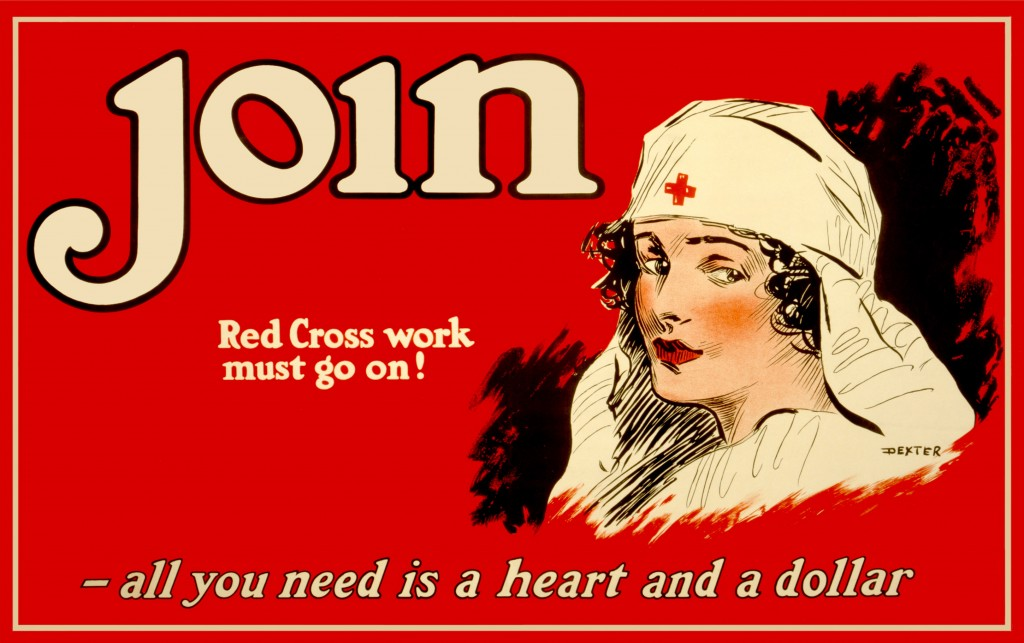
After the war, Clara returned to the United States, but kept in contact with her colleagues in the Red Cross. The Red Cross recognized Clara as an asset to their organization and believed her to be the perfect person to present membership to the United States. Having been given signed authorization from the president of the Red Cross, Clara took the proposal to enter the international treaty to the president of the United States, Rutherford B. Hayes. Hayes rejected the idea thinking it would cause issues for the United States on the international stage. Undeterred, Clara persisted. After several years of political upheaval, Clara was able to lobby President Chester Arthur and convinced him to sign the treaty, which was subsequently ratified by the Senate. Clara then helped establish a Red Cross charter that was adopted by the United States Congress. This treaty legitimized the American Red Cross (Clara Barton. n.d.).
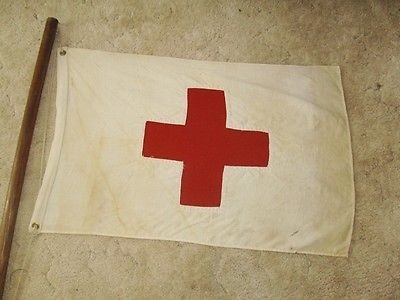
The American Red Cross flag flew for the first time in 1881. Over the next 20 years with Clara in charge, the Red Cross focused primarily on disaster relief. In the same year that the flag first flew on American soil, the Red Cross provided aid to those suffering from a widespread forest fire in Michigan. In 1884, she and 50 volunteers helped victims in Pennsylvania who were suffering from a dam break that caused over 2,000 deaths. Later on, she raised over $120,000 for people who fell victim to a hurricane and tidal wave in Galveston, Texas. In 1893, a hurricane hit the Sea Islands of South Carolina, leaving more than 5,000 dead in its path. Clara and her band of volunteers spend the next 10 months helping a primarily African American population repair and regain their agricultural economy (American Red Cross, 2019).
The American Red Cross' efforts not only stretched from coast to coast, but also expanded globally. For just one of many examples, Clara and volunteers sent railroad cars full of cornmeal and flour to those suffering from a famine in Russia in 1892. Because of Clara's global outreach, several countries honored Clara by awarding her decorations. The Red Cross was relentless in their efforts to bring relief to many, not just on American soil.
When the Spanish-American war broke out, The American Red Cross changed its focus. For the first time ever, they would be delivering supplies and rendering services to American armed forces, along with prisoners of war and Cuban refugees.
At age 83, strong opinions about her age and her management style eventually led Clara Barton to resign as president of the American Red Cross in 1904. However, she did not let that stop her. Clara would prove to be far from finished with her life's work. She turned her efforts towards establishing the National First Aid Association of America (American Red Cross, 2019).
The National First Aid Association of America
Clara Barton had been criticized by others over her style of leadership and lack of delegation in the American Red Cross. After she resigned as President of the Red Cross, there were those who were loyal and followed her as she established the National First Aid Association of America in April of 1905. It was incorporated under the laws of the District of Columbia. She served as the President of this organization for five years.
The National First Aid Association of America worked with the police and fire departments to form brigades that would serve as transportation or ambulances for the sick (Clara Barton Chronology, 2018). She patterned these brigades after the Saint John Ambulance Association of England and the Saint Andrews Association of Scotland. This organization allowed Clara to utilize her experience as a teacher as one of the organization's primary goals was to educate the public in basic First Aid and prepare people to know how to respond to personal and local emergencies. In addition to the educational aspect of preparation, The National First Aid Association assembled first aid kits as well.
Clara's first-hand experience and knowledge of first aid, which she gained during the civil war, left Clara with a great desire to utilize her knowledge and experience and teach it to others. The American Red Cross was not teaching first aid at this time, but The National First Aid Association's educational framework was so successful that the American Red Cross eventually incorporated first aid into their scope of practice. Despite having been forced out of the American Red Cross, Clara continued to influence the organization through her ingenuity and talent for administration.
A book that aided in teaching first aid entitled, "The Barton First Aid Textbook", incorporated Clara Barton's ideas and experience. It was written by the National First Aid Association of America's medical director, H.H. Hartung, M.D. and arranged and illustrated by one of Clara's loyal followers who came with her from the American Red Cross, Roscoe G. Wells. The first edition was published in February of 1906.
The first nursing school in the United States, Bellevue Hospital School of Nursing, opened in New York in 1873 and operated until 1969 when it closed. The curriculum was based on Florence Nightingale's principles, which she taught in the nursing school she opened in 1860 in London, England. This school was called: Nightingale Training School for Nurses (Nursing School, 2019).
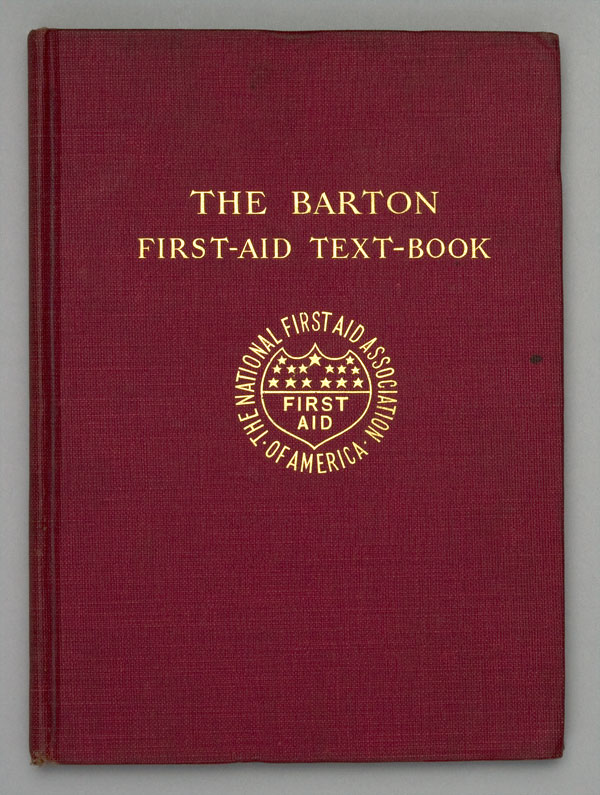
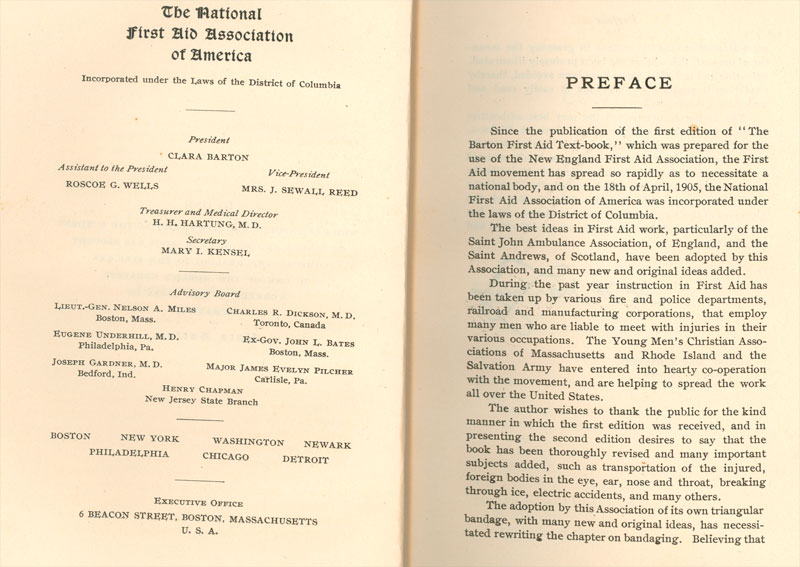
Women's suffrage
In addition to Clara Barton's nursing and humanitarian work during the American Civil War, her subsequent work with the International and American Red Cross, and her founding of the National First Aid Association, Clara also helped with the fight for women's rights. Barton had helped set a precedent for gender equality by being the first woman hired at the U.S. Patent Office who receiving the same pay as men. This was unheard of during this time.
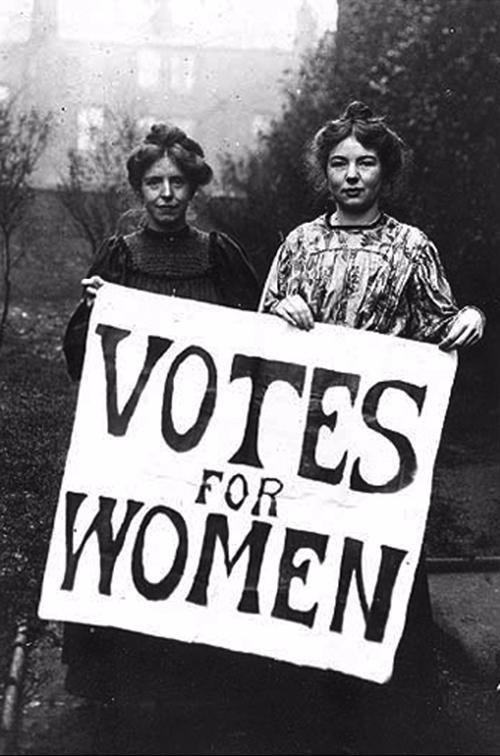
Her efforts to care for wounded soldiers during the Civil War was culturally perceived as strange. It was unusual for women to be caring for men they did not know, because of the sometimes-intimate situations the women would find themselves in order to render the requisite care (Clara Barton Museum, 2018). Clara was the first woman nurse in the civil war and the first to advocate that nursing principles be applied on the battlefield in order to save more lives.
Clara understood her deeds were uncommon, perceived as strange and improper, but she was proud of the work she and other women were doing. She considered herself to be perfectly equal to any man.
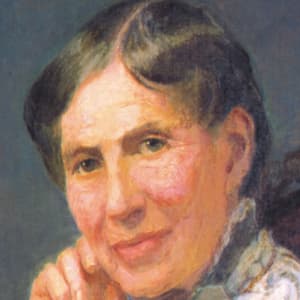
Women's rights had always been important to Clara. She specifically advocated for, "the right [of a woman]to her own property, her own children, her own home, her individual claim before the law, to her freedom of action, to her personal "liberty" as she put it (Clara Barton Museum, 2018). Clara was friends with and supported those who paved the way for women's rights such as Susan B. Anthony, Elizabeth Cady Stanton, Frances D. Gage, and other monumental women at the time (Clara Barton Museum, 2018).
Clara was highly in favor of equal rights for women. As a friend to Susan B. Anthony, Clara had the opportunity to speak at multiple conventions for women's suffrage, including the first national women's suffrage convention held in Washington, D.C. (1869) and National American Woman Suffrage Association (NAWSA) Conventions of 1893, 1902, 1904, and 1906 (Clara Barton, 2019).
At the 1902 Convention, Barton loaned them 30 flags given to her from foreign nations that were displayed at the NAWSA convention to show their support. Even in her later years, Barton was an advocate for women's rights. When she was no longer able to attend the conventions, she would send letters to be read aloud to the audience. In one of those letters she described her life by saying, "The door that nobody else will go in at, seems always to swing open widely for me."
In 1907 and 1910 the NAWSA sent her thank you greetings to show their appreciation for her continuous efforts (Clara Barton, 2019). Barton passed away at the age of 91 in her home in Glen Echo, Maryland April 12th, 1912 due to a fatal case of Pneumonia. Clara Barton died being highly respected for all of her contributions to health and wellbeing of society. Clara's reputation has carried on to the present day, and because of her contributions to the nursing profession they have established a National Site where you can tour her home and visit the places where she made monumental contributions to the world we enjoy today.
References
- American Battlefield Trust. (2018). Clara Barton. Retrieved from https://www.battlefields.org/learn/biographies/clara-barton
- American Red Cross (2019). Clara Barton. Retrieved from https://www.redcross.org/about-us/who-we-are/history/clara-barton.html
- Britannica, T. E. (2019). Clara Barton. Retrieved from https://www.britannica.com/biography/Clara-Barton
- Clara Barton. (2019). Retrieved from https://rrlc.org/winningthevote/biographies/clara-barton/
- Clara Barton Childhood. (n.d). Retrieved from nhdclarabarton.weebly.com/childhood.html
- Clara Barton Chronology 1870-1912. (2018). National Park Service. Retrieved from https://www.nps.gov/clba/learn/kidsyouth/chron3.htm
- Clara Barton Family. (n.d.). Retrieved from http://nhdclarabarton.weebly.com/family.html
- Clara Barton. (n.d.). Retrieved June 5, 2019, from https://www.redcross.org/about-us/who-we-are/history/clara-barton.html
- Clara Barton Museum. (2018). Clara Barton Broke Barriers for Nineteenth Century Women. Retrieved from http://www.clarabartonmuseum.org/broke-barriers/
- Clara Barton. Wikipedia, Wikimedia Foundation. Retrieved from en.wikipedia.org/wiki/Clara_Barton.
- Editors, H. (2009). Clara Barton. Retrieved from https://www.history.com/topics/womens-history/clara-barton#section_1
- Michals, D. (2015). Clara Barton. Retrieved from https://www.womenshistory.org/education-resources/biographies/clara-barton
- National Park Service (2018). Clara Barton. Retrieved from https://www.nps.gov/people/clara-barton.htm
- Nursing School." Wikipedia, Wikimedia Foundation, 23 May 2019, en.wikipedia.org/wiki/Nursing_school.
- Stevenson, Keira. "Clara Barton." Clara Barton, Aug. 2017, p. 1. EBSCOhost, search.ebscohost.com/login.aspx?direct=true&db=f6h&AN=18010715&site=eds-live.
- Van Hartesveldt, Fred R. "Clara Barton." Salem Press Biographical Encyclopedia, 2018. EBSCOhost, search.ebscohost.com/login.aspx? direct=true&db=ers&AN=88806959&site=eds-live.
- Clara Barton. (2014). Biography.com.A&E Networks Television, 15 May 2019, www.biography.com/activist/clara-barton
- Clara Barton. (n.d.). Encyclopaedia Britannica. Retrieved August 6, 2019, from https://www.britannica.com/biography/Clara-Barton/media/1/54432/154145
- Jones, Robert. "Clara Barton - American Hero." Infinite Fire, 27 Dec. 2015, infinitefire.org/info/clara-barton-american-hero/
- Kirkpatrick, Melanie. "'Clara Barton' Civil War' and 'Louisa on the Front Lines' Review: Conquering New Territory." The Wall Street Journal, Dow Jones & Company, 1 Mar. 2019, www.wsj.com/articles/clara-bartons-civil-war-and-louisa-on-the-front-lines-review-conquering-new-territory-11551451034.
- Kunkel, Katherine. "Clara Barton: War Hero, Educator, and supporter of Women's Rights." Sutori, 2017. Retrieved from https://www.sutori.com/story/clara-barton-war-hero-educator-and-supporter-of-women-s-rights--oPL7MgKYJ4dJuzNqYU3GXQRy
- Markel, Dr. Howard. "Clara Barton's Crusade to Bring the Red Cross to America." PBS, Public Broadcasting Service, 22 May 2014, www.pbs.org/newshour/health/clara-barton-founding-american-red-cross.
- National Park Service (2018). Clara Barton National Historic site. Retrieved from https://www.nps.gov/museum/exhibits/clba/exb/Work/Teacher/CLBA113_pg4_5.html
- Vintage Red Cross Flag with pole. (n.d.). Retrieved from https://www.worthpoint.com/worthopedia/vintage-red-cross-flag-pole-478267949
- Young Clara Barton. (n.d.). Retrieved August 8, 2019, from https://www.timetoast.com/timelines/clara-bartron